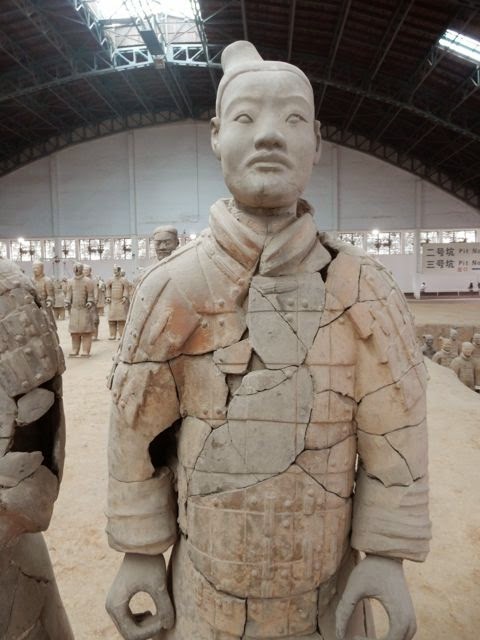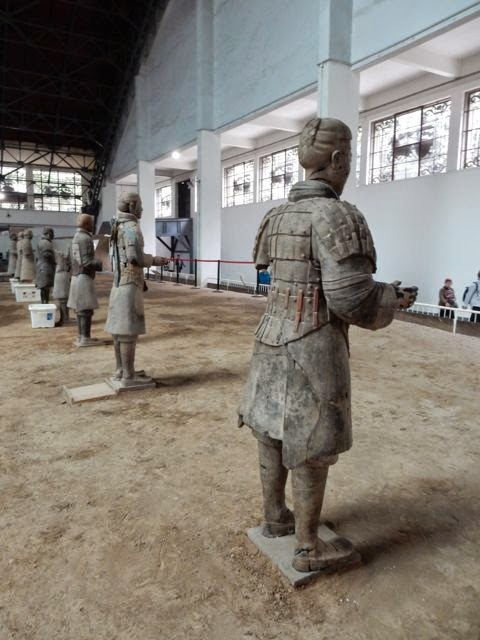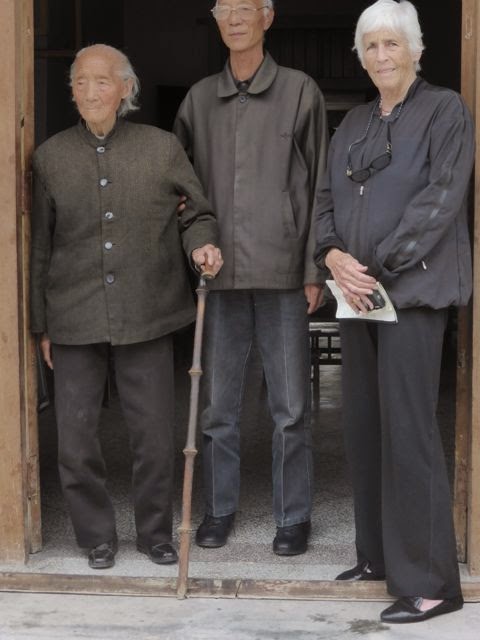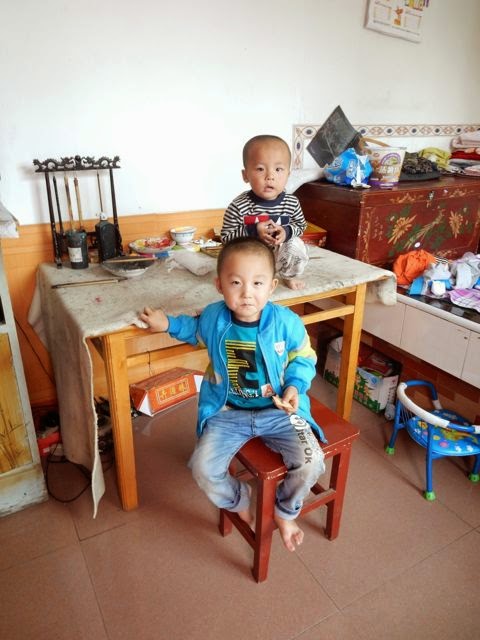 |
| Masses of warriors in pit |
Emperor QinShihuang, the same emperor who built the Great Wall and unified China in 221 BC during the Qin Dynasty, standardized writing, measures and weights, lengths of axles, and spent 38 years in power until he died on a journey on a hot summer day to see the production of life-sized warriors being cast to accompany him in the after world. He chose to be buried among the Qin Kings, (he was the end of the Chinese Kings and first of the Emperors in China history) where people could for the first time worship him at his grave site, which wasn’t the tradition, so we can surmise he was amused by his own greatness. But he was responsible for the spectacular Xi’an terra-cotta warriors and horses and chariots that have become the top archeological dig in the world. Truly, it is like something you have never imagined or seen.
 |
| Warriors ready to stand together |
Qin was the first Han Emperor and had big ideas, destroying Confucian papers, building a palace with a labor force of two million laborers, all for wanting to make sure he had good protection and plenty of entertainment in the world to come. He wanted immortality and tried every gimmick, although nothing guaranteed the way to eternity. His father, the ultimate China king, had died when his son was 13. His mother had many affairs and so he loathed her as much as he feared death. No one could mention death to him, nor the number “4” which in Chinese has the same sound.
 |
| Close-up of warrior |
We left the hotel sufficiently early to be first at the gate, so to speak. The enormous area underground is the top hot spot on anyone’s journey, and worth every minute. Walk in to the door of Pit One, and you think your eyes are crazy. It goes so far the horizon is not visible. And down inside giant pits which have been chipped away to restor the parts and wholes of the warrior army, we could see the soldiers who already been put together, and the parts of many still under reform or just abandoned to be parts forever. Each warrior face is distinct because each model at the time was unique. Researches found there are 6000 terra-cotta warriors and horses buried in this pit alone. There are two more pits just as large in operation but not as rich in numbers.. Uniforms of the warriors are distinct but hair dos are fascinating. Some men wore crossbows and arrows, others spears. It IS overwhelming how this all came together and now is being unearthed piece by piece. Few of the soldiers are in a complete state, so conservers in blue shirts work diligently to put broken pieces in proper places. Everything is measured, copied, recorded and coddled.
 |
| Great hair-do |
We had the distinct privilege of going into the work area, as they say, “on the floor.” There I could stand face to face with history. Each countenance was handsome in its way, and similar in height. Hair styles caught my eye, and some men actually in the day wore armor with shingles made from bronze and jade squares and inlaid stones, so must have weighed double that of the man . A few had a tidbit of color on their armor, which gave the researches an inkling of the whole that was. I got close up with the horses and even they had different sized ears, and eyes and shapes of their faces. All were pony size. I was allowed to walk freely in the area where the warriors were being pieced together. Blessings to all those who do this tedious but exciting restoration of history. A Wow Event.
 |
| Horses smile |
We also visited Pit 2 and Pit 3, which were more recently discovered. In Pit 2 they found 1300 pottery figures, all military forces kneeling or standing archers and facing eastward. Here also were 64 complete chariots human size. Made in wood at their creation, these had rotted out when unearthed. And then there is the cavalry; 108 cavalry men standing in front of their saddled war-horses, holding reins in the right hand and a bow in the left hand, revealing bonus information to researches about military strategy of the Qin army.
 |
| On the floor with the guys |
In 1976 pit 3 revealed 68 warriors standing face to face with backs to the wall suggestion they were like body guards. Their weapons are different from the others and one soldier held a “shu” with no blade, which suggests he was a guard of honor. Fragments of deer horns also appeared, ritual objects for generals praying for protection from the gods before battle. It is now called the command center of the entire army.
 |
| A tad of color found |
A visitor could spend days wandering the pits not only out of curiosity of what you might see that you missed, but also to get a grasp of the whole place, the magnitude of the discovery and the work being done, is overwhelming and the park and landscape around it is peaceful and far from urban noise and pollution. And if you walk through the tourist shops, you just might be able to meet the farmer now celebrity who on March 29, 1974, found the first pottery fragment while digging in for a well in search of water. Other farmers also found fragments and ancient bronze weapons. His wrinkled strong hand is ready to shake yours and he does sign books for a few dollars.
 |
| Fresh grapes from the vineyards |
From here we headed to farmland for lunch with a farmer-artist in his home. Farmers are considered prosperous, intellectuals and talented artists and their houses are comfortable and roomy. Beds are built on top of brick rectangles where hot coals can be loaded underneath from the outside to keep the beds warm. As we drove through rich farm land – corn was being harvested – we passed plots of lands (some with cemeteries in the middle as country people can still be buried in the ground, while city folk must be cremated ) lined with lantern trees, poplars, persimmon trees, and vineyards, we stopped to buy fresh grapes, each grape as big as a crab apple and sufficiently juicy to be made into grape juice. Vineyard owners sold them alongside the road. Also, I was told, kiwis were discovered in this province as were gooseberries.
 |
| Farmers’ area public art |
Mr. Zhang had arranged for us to meet a lady who was from the bound-feet generation. These are rare to find anymore as the foot-binding was outlawed in 1912. We followed Mr. Zhang on his motorcycle and as we approached the area where she lived, another motorcycle joined for getting us to the right house. It was a rather poor area, and the house was very open, and dark. Lights are not used to save electricity. Tall thin Mr. Wei met us and immediately gave each of us a cigarette, then offered to light them for us. But we were able to decline politely. It was tradition. Then as we sat on stools the size of a kindergarten child’s seat, we waited til his 98 year old mother arrived. When she did, I thought she was a man, as she dressed in a brown mao-collar type suit that the people wore during the Cultural Revolution. She wore men’s leather shoes and hardly had any hair. But her face was alert and she walked with the aid of a cane. As we talked, Mr. Wei asked his mother to remove a shoe. She did. She wore brown socks, but you could get an idea of the shape of her foot. Actually, she was a lucky one. When her mother began to bind her feet at age 3, it caused such horrible pain she cried and screamed for days, her son told us. So the mother, violating the law, unbound her feet after about a month, and just supposed she would not find a husband, but she did.
 |
| Mr. Wei and his 98 yr old grandmother |
Foot -binding began in the Five Dynasties and Ten States period of the 10th century. An emperor with a favored concubine, a dancer, who built a gilded stage in the shape of a lotus and danced for him on her toes (binding her feet in a hoof shape that looked like a lotus blossom), he was so infatuated and sexually aroused that it became chic and a requirement for girls beautiful or not, who wanted to get married. Other concubines began to imitate her to get the emperor’s favor. Remember, there were thousands of concubines, but few actually ever laid with the emperor. By the 12th century and the early Qing Dynasty in the 17th century, maidens who wanted to marry had to suffer this painful distortion of their feet.
Manchu women were forbidden to foot bind, and many Christian missionary wives over the years fought to have it stopped. Although this was most popular in the wealthy class, poor women with great beauty would also bind their feet in hopes of attracting a wealthy spouse. Considered erotic, this was also a way to restrain women from stepping outside their boundaries. It limited their mobility, so she could not take part in politics, social life and the worldly things. Bound feet signified the woman was dependent on her family and husband and became a symbol of chastity and male ownership. She was constantly under the eye of servants and those who had to help her get around.
- the color: white is the most valuable; a touch of lavender with light apple green marks in it is the most valuable color. It is bright and not dark.
- Translucent – hold up to the light to see if you can see through it.
- The shape made by men. The first cut is the most valuable for any jewelry. The pieces of green jade that are heavily or ornately carved are not high quality. They are soft jade or the carving could not be done in such detail. Hard jade is the most

